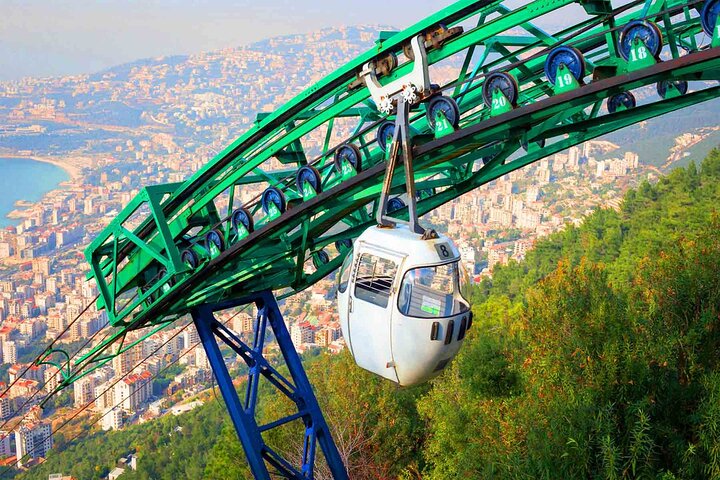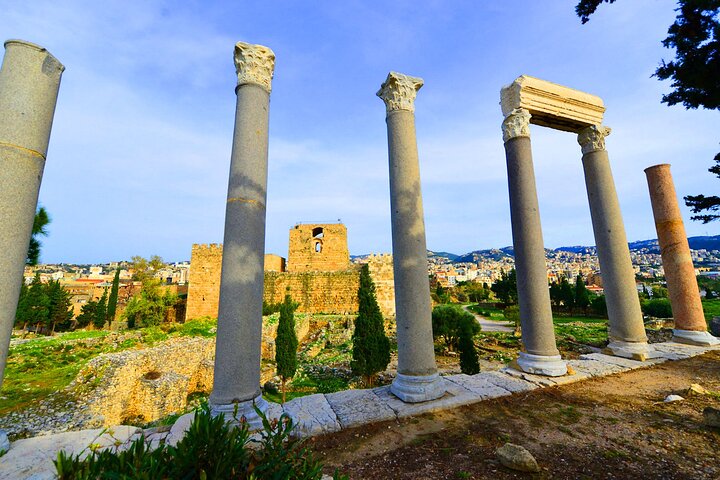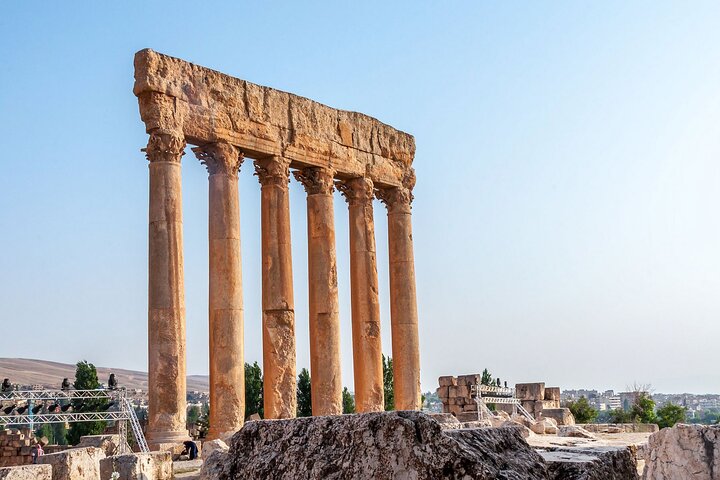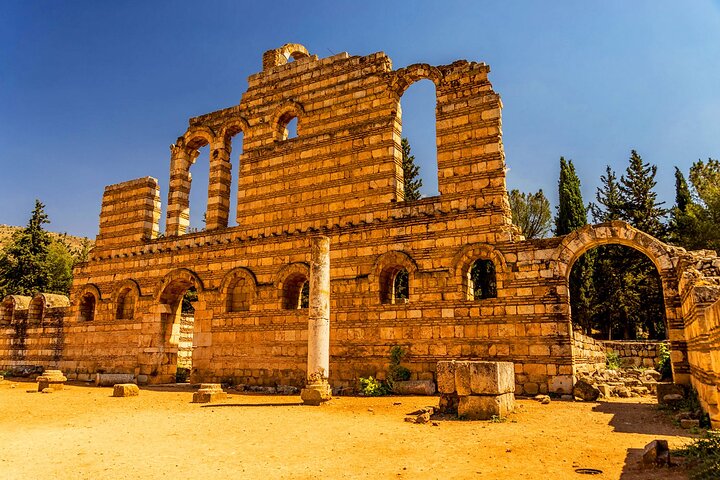4-Day Lebanon Tour from Beirut with Airport Transfer
Share this tour
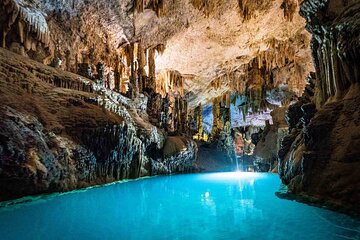
Offered languages
- English
On a visit to Lebanon, Baalbek is probably the first place tourists go after Byblos. And rightly so. The rich history and culture of the Roman ruins of Baalbek is sure to leave you dumbstruck.
On this 4-day tour from Beirut, you will explore the archeological sites of Byblos, Anjar and Baalbek. You will indulge in the natural beauty of Jeita grotto and Jounieh Bay. You'll visit our lady of Lebanon, enjoy amazing experiences and taste an authentic Lebanese wine at the well-known home of wine, Bekaa valley. The experienced guides will give you an inside overview of the places, and tell you interesting stories and facts.
What's Included
Lunch
Breakfast
Meeting and pickup
We'll meet you upon your arrival at Beirut airport. Our representative will be waiting you holding a sign with your name on it.
Itinerary
-
1
The most convenient way to get to hotels. Our private airport transfer service is available 24 hours and is perfect for passengers needing to get from Beirut Airport to any location in the area. Passengers are greeted at the arrival terminals and a vehicle is waiting ready to leave as soon as the passenger checks in. NO luggage restrictions, NO waiting time fees, NO cancellation fees, delays, etc. This is the most requested service by passengers traveling to Beirut.
15 minutes • Admission ticket free -
2Beirut
Welcome to Beirut, our professional driver will transfer you to your hotel in Beirut. Relax and get ready for your tour on the next day!
20 minutes • Admission ticket free -
3Jeita Grotto
The Jeita Grotto, a system of two separate, but interconnected, karstic limestone caves which have formed over millions of years, is the longest cave complex in the Middle East. It is located 300 metres above sea level and has a height difference of 305 metres. The Jeita upper cave has an overall length of 2,130 metres and contains a great concentration of a variety of crystallized formations such as stalactites, stalagmites, columns, mushrooms, ponds, curtains and draperies. The lower gallery which has an overall length of 6,200 metres is located 60 metres below the upper gallery. It is traversed by a smooth underwater river and a lake.
1 hour 30 minutes • Admission ticket included -
4The Shrine of Our Lady of Lebanon
The shrine of our Lady of Lebanon is one of the most important shrines in the world honoring the Virgin Mary and located in Harissa, a key Christian pilgrimage site in Lebanon. The shrine is highlighted by a huge, 15-ton bronze statue of the Immaculate Conception, Mother of God. It is 8.5 m high and has a diameter of five meters. The Virgin Mary stretches her hands towards Beirut overlooking the Bay of Jounieh in one of the most attractive panoramic views in the world.
30 minutes • Admission ticket free -
5Churches of Harissa
Harissa is a key Christian pilgrimage site with a shrine dedicated to Our Lady of Lebanon The pilgrimage site is a large, 15-ton bronze and a painted white statue of Virgin Mary, known as Our Lady of Lebanon or Notre Dame du Liban, with her arms, stretched. The statue was made at the end of the 19th century and inaugurated in 1908. Inside the statue's base, there is a small chapel. As well, A huge cathedral built of concrete and glass stands adjacent to the statue. Among other churches of various Christian denominations in the vicinity of Harissa are the Byzantine-style, Melkite Greek Catholic basilica of St. Paul, located south of the statue and built between 1948 and 1998, the Apostolic Nunciature (Papal Embassy), as well as the residences of four patriarchs of Eastern Catholic Churches
15 minutes • Admission ticket free -
6
The Telepherique is One of The oldest and most visited tourist attractions in Lebanon It is a gondola lift system located in Jounieh, a city in Lebanon,16 km north of Beirut that transports passengers above the pine-forested steep mountain, to an altitude of 650 meters, arriving at Our Lady of Lebanon shrine in Harissa offering breathtaking views of the bay of Jounieh and the surrounding city.
20 minutes • Admission ticket included -
7Byblos
Byblos, one of the oldest Phoenician cities. Inhabited since Neolithic times, it has been closely linked to the legends and history of the Mediterranean region for thousands of years. Byblos is also directly associated with the history and diffusion of the Phoenician alphabet.
2 hours • Admission ticket free -
8Byblos Citadel
Byblos Castle, a restored 12th-century Crusader castle surrounded by a 10m-wide dry moat is located just inside the Byblos' atmospheric archaeological site that contains the ruins of the Temple of Baalat Gebal and the Temple of the Obelisks. It's an impressive building that offers an excellent perspective over the ruins from the top of its foursquare keep. A series of Bronze Age dwellings is clearly visible below the walls as you look towards the sea. Inside the castle, there's a small museum and a room with information panels outlining the city's history.
1 hour • Admission ticket included -
9
Byblos old souk is an old market where tourists can shop for souvenirs and antiques, or simply stroll along the old cobblestone streets and enjoy the architecture.
10 minutes • Admission ticket free -
10
Byblos Port is an ancient port in Byblos and is believed by the Lebanese to be the oldest port in the world. Around 3000 BC, Byblos Port was the most important timber shipping center in the eastern Mediterranean
10 minutes • Admission ticket free -
11
Baalbek, is home to the Baalbek temple complex which includes two of the largest and grandest Roman temple ruins: the Temple of Bacchus and the Temple of Jupiter. It was inscribed in 1984 as an UNESCO World Heritage site. This Phoenician city, where a triad of deities was worshipped, was known as Heliopolis during the Hellenistic period. It retained its religious function during Roman times, when the sanctuary of the Heliopolitan Jupiter attracted thousands of pilgrims. Baalbek, with its colossal structures, is one of the finest examples of Imperial Roman architecture at its apogee.
2 hours • Admission ticket free -
12Temples of Baalbek
The complex of temples at Baalbek is located at the foot of the south-west slope of Anti-Lebanon, bordering the fertile plain of the Bekaa at an altitude of 1150 m. The city of Baalbek reached its apogee during Roman times. Its colossal constructions built over a period of more than two centuries, make it one of the most famous sanctuaries of the Roman world and a model of Imperial Roman architecture. Pilgrims thronged to the sanctuary to venerate the three deities, known under the name of the Romanized Triad of Heliopolis, an essentially Phoenician cult (Jupiter, Venus and Bacchus).
1 hour 30 minutes • Admission ticket included -
13Temples of Baalbek
Baalbeck roman ruins, Lebanon's greatest Roman treasure, can be counted among the wonders of the ancient world. The largest and most noble Roman temples ever built, they are also among the best preserved.
1 hour 30 minutes • Admission ticket included -
14
The Temple of Jupiter is a colossal Roman temple, the largest of the Roman world, situated at the Baalbek complex in Heliopolis. The temple served as an oracle and was dedicated to Jupiter Heliopolitanus. It is not known who designed the temple, nor exactly when it was constructed. Work probably began around 16 BC and was nearly complete by about ad 60. It is situated at the western end of the Great Court of Roman Heliopolis, on a broad platform of stone raised another 7 m (23 ft) above the huge stones of the foundation, three of which are among the heaviest blocks ever used in a construction. It was the biggest temple dedicated to Jupiter in all the Roman empire. The columns were 30 meters high with a diameter of nearly 2.5 meters: the biggest in the classical world. It took three centuries to create this colossal temple complex.
30 minutes • Admission ticket included -
15
The Temple of Bacchus is part of the Baalbek temple complex located in the Bekaa Valley, Lebanon. The temple complex is considered an outstanding archaeological and artistic site of Imperial Roman Architecture and was inscribed as an UNESCO World Heritage site in 1984. The Temple of Bacchus is one of the best preserved and grandest Roman temple ruins; its age is unknown, but Its fine ornamentation can be dated to the second century CE.
30 minutes • Admission ticket included -
16
The Temple of Venus was built in the third century. Built on a horseshoe-shaped platform, it consists of a circular shrine with a square entrance that is almost as big. The outer façade of the shrine is graced by five niches, which means that there is not a single square wall. In the niches are representations of doves and shells, which has been taken as evidence that the shrine was dedicated to Venus.
30 minutes • Admission ticket included -
17Sayyida Khawla Shrine
The Mosque of sayeda Khawla in Baalbek, Lebanon is erected on the site where Sayyida Khawla, the daughter of Imam al-Hussein, the grandson of the Prophet Muhammad, is believed to have been buried. People of Baalbek believe that when the caravan of captives of Karbala passed Baalbek, The daughter of Imam al-Hussein, called Khawla passed away and was buried there.
Admission ticket free -
18
The Stone of the Pregnant Woman is a worked Roman monolith in Baalbek, Lebanon. Together with another ancient stone block nearby, it is among the largest monoliths ever quarried. The two building blocks were presumably intended for the nearby Roman temple complex, and are characterized by a monolithic gigantism that was unparalleled in antiquity.
15 minutes • Admission ticket free -
19Anjar
The city of Anjar was founded by Caliph Walid I at the beginning of the 8th century. The ruins reveal a very regular layout, reminiscent of the palace-cities of ancient times, and are a unique testimony to city planning under the Umayyads.
45 minutes • Admission ticket free -
20Umayyad Ruins of Aanjar
The Umayyad Ruins of Aanjar bears outstanding witness to the Umayyad civilization and a good example of an inland commercial centre, at the crossroads of two important routes: one leading from Beirut to Damascus and the other crossing the Bekaa and leading from Homs to Tiberiade. The site of this ancient city was only discovered by archaeologists at the end of the 1940s. The ruins of Anjar include the walls of the Umayyad palace, harems, a mosque, the great palace of the Caliph, thermal baths, and many pillars which include some elements of the Roman architectural style.
45 minutes • Admission ticket included -
21Chateau Ksara
Château Ksara is a wine company in The Beqaa Valley Lebanon. Founded in 1857 by Jesuit priests, château Ksara developed the first dry wine in Lebanon. Château Ksara produces approximately 3 million bottles annually. Its wines are exported to over 40 countries.
1 hour • Admission ticket not included -
22Beirut
Prepare yourself and your luggage to leave Lebanon after enjoying the three-day holiday package. We hope for you to repeat your visit and see you again in Lebanon!
20 minutes • Admission ticket free -
23
After check-out at your hotel in Beirut our representative will be awaiting you and transfer you to Beirut Airport 2-3 hours before your flight departure. We wish for you to enjoy your journey and have a safe flight.
15 minutes • Admission ticket free
Arrival day: Airport Pick-up
Jeita Grotto, Harissa & Byblos
Baalbek, Anjar & Chateau Ksara
Departure day: Airport Drop-off
Additional info
- Suitable for all physical fitness levels
Tags
Cancellation Policy
If you cancel at least 6 full day(s) before the scheduled departure time, you will receive a full refund.
If you cancel between 2 and 6 day(s) before the scheduled departure time, you will receive a 50% refund.
If you cancel within 2 day(s) of the scheduled departure, you will receive a 0% refund.
Show more
Cancellation Policy
- For a full refund, you must cancel at least 6 full days before the experience’s start time.
- For a 50% refund, you must cancel 2–6 full days before the experience’s start time.
- If you cancel less than 2 full days before the experience’s start time, the amount you paid will not be refunded.
Rating
Your guide to the flawless travel experience

